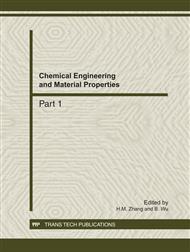p.1095
p.1100
p.1105
p.1109
p.1113
p.1117
p.1123
p.1128
p.1132
Photocatalytic Oxidation of Methyl Orange over Titania-Bearing Blast Furnace Slag Photocatalysts and Effects of Cr(VI) under Visible Irradiation
Abstract:
Using sulfate-modified titanium-bearing blast furnace slag (STBBFS) as photocatalyst, decolorization efficiency of methyl orange (MO) in the absence and presence of Cr(VI) were studied. The effect of the initial concentration of Cr(VI) on the decolorization efficiency of MO at pH=1.5 has been investigated. The results indicate that the acidic solutions are favorable for the photocatalytic oxidation of MO in the absence and presence of Cr(VI), and the optimum pH for oxidation of MO is 1.5. In the presence of Cr(VI), decolorization efficiency and adsorption efficiency of MO rapidly increased with the increase of Cr(VI) concentration, indicating a strong promoting effect of Cr(VI) to oxidation of MO. The increasing in decolorization efficiency of MO in the compound system can be attributed to three main reasons: (1) oxidation of MO by Cr(VI); (2) the high affinity of MO to catalyst surface; (3) Moreover, the addition of Cr(VI) species able to act as electron scavengers to catalyst surface promotes the effective separation of electron-hole in the photocatalytic processes, and hence promote the increase of decolorization efficiency of MO in Cr(VI)-MO system under visible irradiation. FTIR spectral analysis showed that all these characteristic peaks of Cr(VI) and MO disappear after photoreaction, indicating the degradation of Cr(VI) and MO.
Info:
Periodical:
Pages:
1113-1116
Citation:
Online since:
December 2011
Authors:
Price:
Сopyright:
© 2012 Trans Tech Publications Ltd. All Rights Reserved
Share:
Citation:


